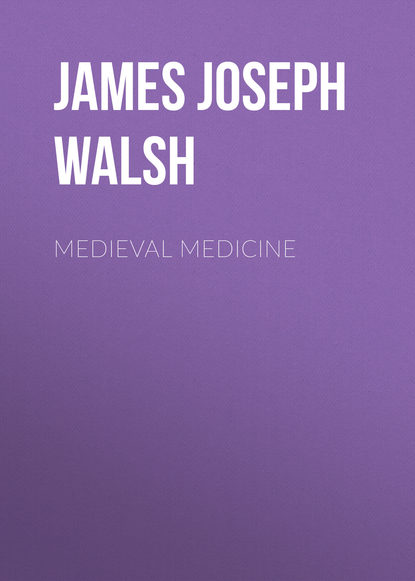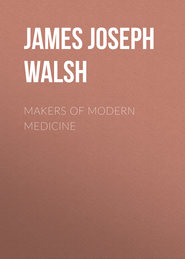По всем вопросам обращайтесь на: info@litportal.ru
(©) 2003-2024.
✖
Medieval Medicine
Настройки чтения
Размер шрифта
Высота строк
Поля
Or mouth that waters—surest sign of all.
Pure air and sunlight were favourite tonics at Salerno—
Let air you breathe be sunny, clear, and light,
Free from disease or cess-pool’s fetted blight.
Taking “a hair of the dog that bit you” was, however, a maxim with Salernitans for the cure of potation headaches.
Art sick from vinous surfeiting at night?
Repeat the dose at morn, ’twill set thee right.
The tradition with regard to the difficulty of the digestion of pork, which we are trying to combat in the modern time, had already been established at Salerno. The digestibility of pork could, however, be improved by good wine.
Inferior far to lamb is flesh of swine,
Unqualified by gen’rous draughts of wine;
But add the wine, and lo! you’ll quickly find
In them both food and medicine combined.
Milk for consumptives was a favourite recommendation. The tradition had come down from very old times, and Galen insisted that fresh air and milk and eggs was the best possible treatment for consumption. The Salernitan physicians recommended various kinds of milk, goat’s, camel’s, ass’s, and sheep’s milk as well as cow’s. It is probable, as I pointed out in my “Psychotherapy,” that the mental influence of taking some one of the unusual forms of milk did a good deal to produce a favourable reaction in consumptives, who are so prone to be affected favourably by unusual remedies. The Regimen warned, however, that milk will not be good if it produces headache or if there is fever. Apparently some patients had been seen with the idiosyncrasy for milk, and the tendency to constipation and disturbance after it which have been noted also in the modern time.
Goat’s milk and camel’s, as by all is known,
Relieve poor mortals in consumption thrown;
While ass’s milk is deemed far more nutritious,
And e’en beyond all cow’s or sheep’s, officious.
But should a fever in the system riot,
Or headache, let the patient shun this diet.
Salerno’s common sense with regard to diet is very well illustrated by a number of maxims. Diet tinkering was not much in favour.
We hold that men on no account should vary
Their daily diet until necessary:
For, as Hippocrates doth truly show,
Diseases sad from all such changes flow.
A stated diet, as it is well known,
Of physic is the strongest cornerstone—
By means of which, if you can nought impart,
Relief or cure, vain is your Healing Art.
They believed firmly that many of the conditions of eating were quite as important as the diet itself, and said:
Doctors should thus their patients’ food revise—
What is it? When the meal? And what its size?
How often? Where? lest, by some sad mistake,
Ill-sorted things should meet and trouble make.
They recommended the various simples, mallow, mint, sage, rue, the violet for headache and catarrh, the nettle, mustard, hyssop, elecampane, pennyroyal, cresses, celandine, saffron, leeks—a sovereign remedy for sterility—pepper, fennel, vervaine, henbane, and others. There were certain special affections, as hoarseness, catarrh, headaches, fistula, for which specific directions for cure were given. Here for instance are the directions to be given a patient suffering from rheum or catarrh. The verses conveyed interesting information with nice long names for the various affections, as well as the directions for its management.
Fast well and watch. Eat hot your daily fare,
Work some, and breathe a warm and humid air;
Of drink be spare; your breath at time suspend;
These things observe if you your cold would end.
A cold whose ill-effects extend as far
As in the chest, is known as a catarrh;
Bronchitis, if into the throat it flows;
Coryza, if it reach alone the nose.
The Regimen conveyed a deal of information in compact form. It gives the number of bones in the body as 219 with 32 teeth, and the number of veins as 365, this number being chosen doubtless because of some supposed relation to the number of days in the year. It contains also a good brief account of the four humours in the human body—black bile, blood, phlegm, and yellow bile; and of the four temperaments—the sanguine, the bilious, the phlegmatic, and the melancholy. These four temperaments were discussed at considerable length by all the psychologists and most of the writers on religious life for centuries afterwards, largely on the basis of the information conveyed by the Salernitan handbook. There are descriptions of the symptoms of plethora or excess of blood, of excess of bile, of excess of phlegm, and excess of black bile. The little volume finally contains discussions as to bleeding, its indications, contraindications, as in youth—“Ere seventeen years we scarce need drawing blood”—and in old age; and then of the mode of practising it, and the place whence the blood should be drawn to relieve different symptoms.[5 - English translations of the Regimen were made in 1575, 1607, and 1617. The two latter were printed; the former exists in manuscript in the Library of Corpus Christi College, Oxford. The opening lines of the edition of 1607 deserve to be noted because they are the origin of an expression that has been frequently quoted since.]
Salerno impressed itself much more deeply on surgery than on medicine, for the magnificent development of medieval surgery, the knowledge of which has proved so surprising in our day, began down at Salerno. Some of the details of this phase of Salernitan accomplishment are given in the chapter on Medieval Surgeons of Italy. Roger and Roland and the Four Masters were great original founders in a phase of medical science that proved extremely important for the next three or four centuries. Undoubtedly the presence of a hospital at Salerno, where there were gathered a number of the chronic cases from all over Europe, most of them of the better-to-do classes looking for ease from their ills, gave the incentive to this development. When the natural means of cure, tried for a considerable time, failed, recourse was had to surgery for relief, and often with excellent results. This chapter on Salerno’s history shows how thoroughgoing was the effort of the members of the faculty of the medical school to develop every possible means of aid for their patients, even when that required pioneer work.
Pagel’s appreciation of Salerno’s place in the history of medicine, in his chapter on Medicine in the Middle Ages in Puschmann’s “Handbuch Der Geschichte der Medicin,” Berlin, 1902, gives in very brief space a summary of what was accomplished at Salerno that emphasizes what has been said here, and his authority will confirm those who might possibly continue to doubt of any institution of the Middle Ages having achieved so much. He said:
“If we take up now the accomplishments of the School of Salerno in the different departments, there is one thing that is very remarkable. It is the rich, independent productivity with which Salerno advanced the banners of medical science for hundreds of years, almost as the only autochthonous centre of medical influence in the whole West. One might almost say that it was like a versprengten Keim—a displaced embryonic element—which, as it unfolded, rescued from destruction the ruined remains of Greek and Roman medicine. This productivity of Salerno, which may well be compared in quality and quantity with that of the best periods of our science, and in which no department of medicine was left without some advance, is one of the striking phenomena of the history of medicine. While positive progress was not made, there are many noteworthy original observations to be chronicled. It must be acknowledged that pupils and scholars set themselves faithfully to their tasks to further, as far as their strength allowed, the science and art of healing. In the medical writers of the older period of Salerno, who had not yet been disturbed by Arabian culture or scholasticism, we cannot but admire the clear, charmingly smooth, easy-flowing diction, the delicate and honest setting forth of cases, the simplicity of their method of treatment, which was to a great extent dietetic and expectant; and while we admire the carefulness and yet the copiousness of their therapy, we cannot but envy them a certain austerity in their pharmaceutic formulas, and an avoidance of medicamental polypragmasia. The work in internal medicine was especially developed. The contributions to it from a theoretic and literary standpoint, as well as from practical applications, came from ardent devotees.”
One very interesting contribution to medical literature that comes to us from Salerno bears the title “The Coming of a Physician to His Patient, or an Instruction for the Physician Himself.” It illustrates very well the practical nature of the teaching of Salerno, and gives a rather vivid picture of the medical customs of the time. The instruction as to the conduct of the physician when he first comes into the house and is brought to the patient runs as follows:
“When the doctor enters the dwelling of his patient, he should not appear haughty, nor covetous, but should greet with kindly, modest demeanour those who are present, and then seating himself near the sick man accept the drink which is offered him [sic], and praise in a few words the beauty of the neighbourhood, the situation of the house, and the well-known generosity of the family—if it should seem to him suitable to do so. The patient should be put at his ease before the examination begins, and the pulse should be felt deliberately and carefully. The fingers should be kept on the pulse at least until the hundredth beat in order to judge of its kind and character; the friends standing round will be all the more impressed because of the delay, and the physician’s words will be received with just that much more attention.”
The rest of the advice smacks rather more of sophistication than we care to think of in a professional man, but its display of a profound knowledge of human nature makes it interesting.
“On the way to see the sick person he (the physician) should question the messenger who has summoned him upon the circumstances and the conditions of the illness of the patient; then, if not able to make any positive diagnosis after examining the pulse and the urine, he will at least excite the patient’s astonishment by his accurate knowledge of the symptoms of the disease, and thus win his confidence.”
Salerno taught as well as it could the science of medicine, and initiated great advances in surgery; but it also emphasized the art of medicine, and recognized very clearly that the personality of the physician counted for a great deal, and that his influence upon his patients must be fostered quite as sedulously as his knowledge of the resources of medicine for their ills.
CHAPTER IV
MONTPELLIER AND MEDICAL EDUCATION IN THE WEST
After Salerno the next great medical school was that of Montpellier in the South of France. The conditions which brought about its original establishment are very like those which occasioned the foundation of Salerno. Montpellier, situated not far from the Mediterranean, came to be a health resort. Patients flocked to it from many countries of the West of Europe; physicians settled there because patients were numerous, and medical instruction came to be offered to students. Fame came to the school. The fundamental reason for this striking development of the intellectual life seems to have been that Montpellier was not far from Marseilles, which had been a Greek colony originally and continued to be under Greek influence for many centuries. As a consequence of this the artistic and intellectual life of the southern part of France was higher during the earlier Middle Ages than that of any other part of Europe, except certain portions of South Italy. The remains of the magnificent architecture of the Roman period are well known, and Provence has always been famous for its intellectual and literary life. Among a people who were in this environment, we might well look for an early renaissance of education.
It is not surprising, then, that one of the earliest of the medical schools of modern history around which there gradually developed a university should have come into existence in this part of the world. What is even more interesting perhaps for us, is that this medical school has persisted down to our own day, and has always been, for nearly ten centuries now, a centre of excellent medical education.
There gathered around the story of its origin such legends as were noted with regard to the history of Salerno, and there is no doubt that Jewish and Moorish physicians who became professors there contributed not a little to the prestige of the school and the reputation that it acquired throughout Europe. The attempt to attribute all of the stimulus for the intellectual life at Montpellier to these foreign elements is, however, simply due to that paradoxical state of mind which has so often tried to minimize the value of Christian contributions to science and the intellectual life, even by the exaggeration of the significance of what came from foreign and un-Christian sources. Proper recognition must be accorded to both Jewish and Moorish factors at Montpellier, but the one important element is that these foreign professors brought with them, even though always in rather far-fetched translations, the ideas of the great Greek masters of medicine to which the region and the people around Montpellier were particularly sensitive, because of the Greek elements in the population, and hence the development of a significant centre of education here.
The date of the rise of the medical school at Montpellier is, as suggested by Puschmann, veiled in the obscurity of tradition. There seems to be no doubt that it goes back to as early as the tenth century, it was already famous in the eleventh, and it attracted students from all over Europe during the twelfth century. When Bishop Adalbert of Mainz came thither in 1137, the school possessed buildings of its own, as we learn from the words of a contemporary, Bishop Anselm of Havelberg. St. Bernard in a letter written in 1153 tells that the Archbishop of Lyons, being ill, repaired to Montpellier to be under the treatment of the physicians there. Perhaps the most interesting feature of this letter is the fact that the good Archbishop not only spent what money he had with him on physicians, but ran into debt.
The two schools, Salerno and Montpellier, came to be mentioned by writers of the period as representing the twins of medical learning of the time. John of Salisbury, a writer of the early thirteenth century, declares that those who wished to devote themselves to medicine at this time went either to Salerno or Montpellier. Ægidius or Gilles de Corbeil, the well-known physician, and Hartmann von der Aue, the Meistersinger, both mention Salerno and Montpellier, usually in association, in their writings, and make it very clear that in the West at least the two names had come to be almost invariably connected as representing rival medical schools of about equal prominence.
The reputation of Montpellier spread in Italy also, however, and we have the best evidence for this from an incident that took place in Rome at the beginning of the thirteenth century, which is more fully dwelt on in the chapter on Medieval Hospitals. Pope Innocent III. wanted to create a model hospital at Rome, and made inquiries as to who would be best fitted to organize such an institution. He was told of the work of Guy or Guido of Montpellier, who was a member of the Order of the Holy Ghost and had made a great hospital at Montpellier. Accordingly Guy was summoned to Rome, and the establishment of the Santo Spirito Hospital was entrusted to him. It was on the model of this that a great many hospitals were founded throughout the world, for Pope Innocent insisted that every diocese in Christianity should have a hospital, and Bishops who came on formal visits to the Holy See were asked to inspect the Santo Spirito for guidance in their own diocesan hospital establishments. Many of the hospitals throughout the world came as a result to be hospitals of the Holy Ghost and this contribution alone of Montpellier to the medical world of the time was of great significance and must have added much to her prestige.
Larger Image
HOLY GHOST HOSPITAL (LÜBECK)
From “The Thirteenth: Greatest of Centuries,” by J. J. Walsh
Montpellier, like Salerno, seems to have attracted students to its medical school from all over the world. There were undoubtedly many English there, and probably also Irish and Scotch, though the journey must have been much longer and more difficult to make than is that from America to Europe at the present time. Of course there came many from Spain and from North France and the Netherlands. The fact that a number of Italians went there before the close of the Middle Ages shows how deeply interested were the men of this time in knowledge for its own sake, and indicates that something of that internationality of culture which we are priding ourselves on at the present time, because our students from all countries go far afield for postgraduate work and there is an interchange of professors, existed at this period. In spite of the fact that books were only written by hand, the teaching of distinguished professors had a wide diffusion, and students were quite ready to go through the drudgery of making these handwritten copies of a favourite master’s work. They had plenty of common sense as well as powers of observation, and some of their writing is still of great practical value.
A number of men who are famous in the history of medicine made their medical studies at Montpellier in the twelfth and thirteenth centuries. Among them are Mondeville, who afterwards taught surgery at Paris; and Guy de Chauliac, who was a Papal Physician at Avignon and at the same time a professor at Montpellier, probably spending a certain number of weeks, or perhaps months, each year in the university town. Sketches of these men, and of other students and teachers at Montpellier who reached distinction in surgery, will be found in the chapter on Surgeons of the West of Europe. Some other distinguished Montpellierians deserve brief mention.
Pure air and sunlight were favourite tonics at Salerno—
Let air you breathe be sunny, clear, and light,
Free from disease or cess-pool’s fetted blight.
Taking “a hair of the dog that bit you” was, however, a maxim with Salernitans for the cure of potation headaches.
Art sick from vinous surfeiting at night?
Repeat the dose at morn, ’twill set thee right.
The tradition with regard to the difficulty of the digestion of pork, which we are trying to combat in the modern time, had already been established at Salerno. The digestibility of pork could, however, be improved by good wine.
Inferior far to lamb is flesh of swine,
Unqualified by gen’rous draughts of wine;
But add the wine, and lo! you’ll quickly find
In them both food and medicine combined.
Milk for consumptives was a favourite recommendation. The tradition had come down from very old times, and Galen insisted that fresh air and milk and eggs was the best possible treatment for consumption. The Salernitan physicians recommended various kinds of milk, goat’s, camel’s, ass’s, and sheep’s milk as well as cow’s. It is probable, as I pointed out in my “Psychotherapy,” that the mental influence of taking some one of the unusual forms of milk did a good deal to produce a favourable reaction in consumptives, who are so prone to be affected favourably by unusual remedies. The Regimen warned, however, that milk will not be good if it produces headache or if there is fever. Apparently some patients had been seen with the idiosyncrasy for milk, and the tendency to constipation and disturbance after it which have been noted also in the modern time.
Goat’s milk and camel’s, as by all is known,
Relieve poor mortals in consumption thrown;
While ass’s milk is deemed far more nutritious,
And e’en beyond all cow’s or sheep’s, officious.
But should a fever in the system riot,
Or headache, let the patient shun this diet.
Salerno’s common sense with regard to diet is very well illustrated by a number of maxims. Diet tinkering was not much in favour.
We hold that men on no account should vary
Their daily diet until necessary:
For, as Hippocrates doth truly show,
Diseases sad from all such changes flow.
A stated diet, as it is well known,
Of physic is the strongest cornerstone—
By means of which, if you can nought impart,
Relief or cure, vain is your Healing Art.
They believed firmly that many of the conditions of eating were quite as important as the diet itself, and said:
Doctors should thus their patients’ food revise—
What is it? When the meal? And what its size?
How often? Where? lest, by some sad mistake,
Ill-sorted things should meet and trouble make.
They recommended the various simples, mallow, mint, sage, rue, the violet for headache and catarrh, the nettle, mustard, hyssop, elecampane, pennyroyal, cresses, celandine, saffron, leeks—a sovereign remedy for sterility—pepper, fennel, vervaine, henbane, and others. There were certain special affections, as hoarseness, catarrh, headaches, fistula, for which specific directions for cure were given. Here for instance are the directions to be given a patient suffering from rheum or catarrh. The verses conveyed interesting information with nice long names for the various affections, as well as the directions for its management.
Fast well and watch. Eat hot your daily fare,
Work some, and breathe a warm and humid air;
Of drink be spare; your breath at time suspend;
These things observe if you your cold would end.
A cold whose ill-effects extend as far
As in the chest, is known as a catarrh;
Bronchitis, if into the throat it flows;
Coryza, if it reach alone the nose.
The Regimen conveyed a deal of information in compact form. It gives the number of bones in the body as 219 with 32 teeth, and the number of veins as 365, this number being chosen doubtless because of some supposed relation to the number of days in the year. It contains also a good brief account of the four humours in the human body—black bile, blood, phlegm, and yellow bile; and of the four temperaments—the sanguine, the bilious, the phlegmatic, and the melancholy. These four temperaments were discussed at considerable length by all the psychologists and most of the writers on religious life for centuries afterwards, largely on the basis of the information conveyed by the Salernitan handbook. There are descriptions of the symptoms of plethora or excess of blood, of excess of bile, of excess of phlegm, and excess of black bile. The little volume finally contains discussions as to bleeding, its indications, contraindications, as in youth—“Ere seventeen years we scarce need drawing blood”—and in old age; and then of the mode of practising it, and the place whence the blood should be drawn to relieve different symptoms.[5 - English translations of the Regimen were made in 1575, 1607, and 1617. The two latter were printed; the former exists in manuscript in the Library of Corpus Christi College, Oxford. The opening lines of the edition of 1607 deserve to be noted because they are the origin of an expression that has been frequently quoted since.]
Salerno impressed itself much more deeply on surgery than on medicine, for the magnificent development of medieval surgery, the knowledge of which has proved so surprising in our day, began down at Salerno. Some of the details of this phase of Salernitan accomplishment are given in the chapter on Medieval Surgeons of Italy. Roger and Roland and the Four Masters were great original founders in a phase of medical science that proved extremely important for the next three or four centuries. Undoubtedly the presence of a hospital at Salerno, where there were gathered a number of the chronic cases from all over Europe, most of them of the better-to-do classes looking for ease from their ills, gave the incentive to this development. When the natural means of cure, tried for a considerable time, failed, recourse was had to surgery for relief, and often with excellent results. This chapter on Salerno’s history shows how thoroughgoing was the effort of the members of the faculty of the medical school to develop every possible means of aid for their patients, even when that required pioneer work.
Pagel’s appreciation of Salerno’s place in the history of medicine, in his chapter on Medicine in the Middle Ages in Puschmann’s “Handbuch Der Geschichte der Medicin,” Berlin, 1902, gives in very brief space a summary of what was accomplished at Salerno that emphasizes what has been said here, and his authority will confirm those who might possibly continue to doubt of any institution of the Middle Ages having achieved so much. He said:
“If we take up now the accomplishments of the School of Salerno in the different departments, there is one thing that is very remarkable. It is the rich, independent productivity with which Salerno advanced the banners of medical science for hundreds of years, almost as the only autochthonous centre of medical influence in the whole West. One might almost say that it was like a versprengten Keim—a displaced embryonic element—which, as it unfolded, rescued from destruction the ruined remains of Greek and Roman medicine. This productivity of Salerno, which may well be compared in quality and quantity with that of the best periods of our science, and in which no department of medicine was left without some advance, is one of the striking phenomena of the history of medicine. While positive progress was not made, there are many noteworthy original observations to be chronicled. It must be acknowledged that pupils and scholars set themselves faithfully to their tasks to further, as far as their strength allowed, the science and art of healing. In the medical writers of the older period of Salerno, who had not yet been disturbed by Arabian culture or scholasticism, we cannot but admire the clear, charmingly smooth, easy-flowing diction, the delicate and honest setting forth of cases, the simplicity of their method of treatment, which was to a great extent dietetic and expectant; and while we admire the carefulness and yet the copiousness of their therapy, we cannot but envy them a certain austerity in their pharmaceutic formulas, and an avoidance of medicamental polypragmasia. The work in internal medicine was especially developed. The contributions to it from a theoretic and literary standpoint, as well as from practical applications, came from ardent devotees.”
One very interesting contribution to medical literature that comes to us from Salerno bears the title “The Coming of a Physician to His Patient, or an Instruction for the Physician Himself.” It illustrates very well the practical nature of the teaching of Salerno, and gives a rather vivid picture of the medical customs of the time. The instruction as to the conduct of the physician when he first comes into the house and is brought to the patient runs as follows:
“When the doctor enters the dwelling of his patient, he should not appear haughty, nor covetous, but should greet with kindly, modest demeanour those who are present, and then seating himself near the sick man accept the drink which is offered him [sic], and praise in a few words the beauty of the neighbourhood, the situation of the house, and the well-known generosity of the family—if it should seem to him suitable to do so. The patient should be put at his ease before the examination begins, and the pulse should be felt deliberately and carefully. The fingers should be kept on the pulse at least until the hundredth beat in order to judge of its kind and character; the friends standing round will be all the more impressed because of the delay, and the physician’s words will be received with just that much more attention.”
The rest of the advice smacks rather more of sophistication than we care to think of in a professional man, but its display of a profound knowledge of human nature makes it interesting.
“On the way to see the sick person he (the physician) should question the messenger who has summoned him upon the circumstances and the conditions of the illness of the patient; then, if not able to make any positive diagnosis after examining the pulse and the urine, he will at least excite the patient’s astonishment by his accurate knowledge of the symptoms of the disease, and thus win his confidence.”
Salerno taught as well as it could the science of medicine, and initiated great advances in surgery; but it also emphasized the art of medicine, and recognized very clearly that the personality of the physician counted for a great deal, and that his influence upon his patients must be fostered quite as sedulously as his knowledge of the resources of medicine for their ills.
CHAPTER IV
MONTPELLIER AND MEDICAL EDUCATION IN THE WEST
After Salerno the next great medical school was that of Montpellier in the South of France. The conditions which brought about its original establishment are very like those which occasioned the foundation of Salerno. Montpellier, situated not far from the Mediterranean, came to be a health resort. Patients flocked to it from many countries of the West of Europe; physicians settled there because patients were numerous, and medical instruction came to be offered to students. Fame came to the school. The fundamental reason for this striking development of the intellectual life seems to have been that Montpellier was not far from Marseilles, which had been a Greek colony originally and continued to be under Greek influence for many centuries. As a consequence of this the artistic and intellectual life of the southern part of France was higher during the earlier Middle Ages than that of any other part of Europe, except certain portions of South Italy. The remains of the magnificent architecture of the Roman period are well known, and Provence has always been famous for its intellectual and literary life. Among a people who were in this environment, we might well look for an early renaissance of education.
It is not surprising, then, that one of the earliest of the medical schools of modern history around which there gradually developed a university should have come into existence in this part of the world. What is even more interesting perhaps for us, is that this medical school has persisted down to our own day, and has always been, for nearly ten centuries now, a centre of excellent medical education.
There gathered around the story of its origin such legends as were noted with regard to the history of Salerno, and there is no doubt that Jewish and Moorish physicians who became professors there contributed not a little to the prestige of the school and the reputation that it acquired throughout Europe. The attempt to attribute all of the stimulus for the intellectual life at Montpellier to these foreign elements is, however, simply due to that paradoxical state of mind which has so often tried to minimize the value of Christian contributions to science and the intellectual life, even by the exaggeration of the significance of what came from foreign and un-Christian sources. Proper recognition must be accorded to both Jewish and Moorish factors at Montpellier, but the one important element is that these foreign professors brought with them, even though always in rather far-fetched translations, the ideas of the great Greek masters of medicine to which the region and the people around Montpellier were particularly sensitive, because of the Greek elements in the population, and hence the development of a significant centre of education here.
The date of the rise of the medical school at Montpellier is, as suggested by Puschmann, veiled in the obscurity of tradition. There seems to be no doubt that it goes back to as early as the tenth century, it was already famous in the eleventh, and it attracted students from all over Europe during the twelfth century. When Bishop Adalbert of Mainz came thither in 1137, the school possessed buildings of its own, as we learn from the words of a contemporary, Bishop Anselm of Havelberg. St. Bernard in a letter written in 1153 tells that the Archbishop of Lyons, being ill, repaired to Montpellier to be under the treatment of the physicians there. Perhaps the most interesting feature of this letter is the fact that the good Archbishop not only spent what money he had with him on physicians, but ran into debt.
The two schools, Salerno and Montpellier, came to be mentioned by writers of the period as representing the twins of medical learning of the time. John of Salisbury, a writer of the early thirteenth century, declares that those who wished to devote themselves to medicine at this time went either to Salerno or Montpellier. Ægidius or Gilles de Corbeil, the well-known physician, and Hartmann von der Aue, the Meistersinger, both mention Salerno and Montpellier, usually in association, in their writings, and make it very clear that in the West at least the two names had come to be almost invariably connected as representing rival medical schools of about equal prominence.
The reputation of Montpellier spread in Italy also, however, and we have the best evidence for this from an incident that took place in Rome at the beginning of the thirteenth century, which is more fully dwelt on in the chapter on Medieval Hospitals. Pope Innocent III. wanted to create a model hospital at Rome, and made inquiries as to who would be best fitted to organize such an institution. He was told of the work of Guy or Guido of Montpellier, who was a member of the Order of the Holy Ghost and had made a great hospital at Montpellier. Accordingly Guy was summoned to Rome, and the establishment of the Santo Spirito Hospital was entrusted to him. It was on the model of this that a great many hospitals were founded throughout the world, for Pope Innocent insisted that every diocese in Christianity should have a hospital, and Bishops who came on formal visits to the Holy See were asked to inspect the Santo Spirito for guidance in their own diocesan hospital establishments. Many of the hospitals throughout the world came as a result to be hospitals of the Holy Ghost and this contribution alone of Montpellier to the medical world of the time was of great significance and must have added much to her prestige.
Larger Image
HOLY GHOST HOSPITAL (LÜBECK)
From “The Thirteenth: Greatest of Centuries,” by J. J. Walsh
Montpellier, like Salerno, seems to have attracted students to its medical school from all over the world. There were undoubtedly many English there, and probably also Irish and Scotch, though the journey must have been much longer and more difficult to make than is that from America to Europe at the present time. Of course there came many from Spain and from North France and the Netherlands. The fact that a number of Italians went there before the close of the Middle Ages shows how deeply interested were the men of this time in knowledge for its own sake, and indicates that something of that internationality of culture which we are priding ourselves on at the present time, because our students from all countries go far afield for postgraduate work and there is an interchange of professors, existed at this period. In spite of the fact that books were only written by hand, the teaching of distinguished professors had a wide diffusion, and students were quite ready to go through the drudgery of making these handwritten copies of a favourite master’s work. They had plenty of common sense as well as powers of observation, and some of their writing is still of great practical value.
A number of men who are famous in the history of medicine made their medical studies at Montpellier in the twelfth and thirteenth centuries. Among them are Mondeville, who afterwards taught surgery at Paris; and Guy de Chauliac, who was a Papal Physician at Avignon and at the same time a professor at Montpellier, probably spending a certain number of weeks, or perhaps months, each year in the university town. Sketches of these men, and of other students and teachers at Montpellier who reached distinction in surgery, will be found in the chapter on Surgeons of the West of Europe. Some other distinguished Montpellierians deserve brief mention.











